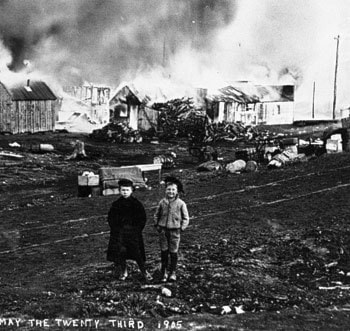Back in Dawson City’s early years, it wasn’t uncommon for calamitous fires to sweep through town.
Houses were built of wood and canvas, heated using wood stoves and lit with candles and oil lamps.
It became such a regular occurrence towards the end of the 19th century that the Dawson Daily News wrote the following headline after a particularly devastating fire in January 1900: “Dawson’s Annual Fire Creates a Loss of Half a Million Dollars.”
A lesser-known fact from that era is that at least three of the fires between 1897 and 1900 involved dance hall girls.
The first fire, in November 1897, was reportedly caused when Dolly Mitchell threw a lamp at another dance hall girl during an argument.
A year later, Mitchell was blamed for another fire after she allegedly left a candle burning on a block of wood, causing flames to consume two hotels.
The worst one happened in April 1899, when a fire that started in the Bodega Saloon spread along the waterfront.
It’s estimated the fire destroyed at least 117 buildings in Dawson City and caused over $1 million in damage.
In January 1900, a fire that started at the Monte Carlo Theatre razed the town’s business district.
The town’s chief steward reported the fire started in a dance hall girl’s room in the theatre after sparks flew from a poorly installed stove pipe.
Newspaper clippings and photographs from the era, taken from the MacBride Museum of Yukon History’s collection, are now on display at the Hougen Heritage Gallery at Arts Underground.
It’s part of a new exhibit titled Fire & Flood: disaster and perseverance in Yukon history.
Leighann Chalykoff, manager of museum services, researched and put the exhibit together.
She said the idea came from the sales of a book, The Survivors, the museum published in 2011.
“It’s a story about the British Yukon Navigation ships that survived on Yukon’s lakes and rivers,” she said.
“The book is selling but we realized that people prefer to hear stories about disasters. Plus we’re always looking at our collection to display photographs that are surprising and rarely seen.”
Chalykoff found mention of the January 1900 fire in Pierre Berton’s Klondike: The Last Great Gold Rush, in which the author recounts how Dawson City residents were quick to start rebuilding their town.
“Less than 12 hours after his saloon was destroyed, Tom Chisholm had erected a big tent labelled ‘Aurora’ and was doing business again,” Berton wrote.
“Although nails sold for twenty-five cents each, the familiar ring of saw and hammer was quickly heard on Front Street.”
The exhibit also features photographs and documents from the Whitehorse fire in 1905, which destroyed nearly every building from Front Street to Second Avenue between Elliott and Steele.
After the fire department’s new equipment broke down, residents began filling up buckets to help douse the flames. One of the volunteers was Yukon poet Robert Service.
Chalykoff also unearthed a diary entry by Anna Puckett, who laments the aftermath.
“I can’t write anymore… Everybody was just walking around the ruins trying to find something when we left,” she wrote in May 1905.
“Nobody spoke much but they were pitching tents on cleared spots, so I supposed the City will build again.”
Fires were not the only danger to Yukon’s towns. Devastating floods were documented in Dawson City in 1925, 1944, 1966, 1969 and 1979, as well as in Mayo in 1936.
An undated picture features a group of men in a canoe as they get ready to dock on a Dawson City sidewalk.
Mayo residents were forced to evacuate their homes during the 1936 flood.
“Slimy mud and silt a foot deep clung to the floors and began to cake and harden,” wrote A.A. Gillespie in the Mayo Miner Flood Supplement on June 20, 1936.
“Walls were stained and mud-splashed. Furniture, clothing, dishes and other household effects lay crumpled and mildewed.”
The Whitehorse Star reported that one woman, who woke up in the middle of the night to witness her greenhouse floating by, promptly fainted.
The most eye-grabbing photograph in the exhibit is the one of the S.S. Casca and S.S. Whitehorse ablaze on June 20, 1974.
The riverboats had been dry docked on the waterfront near the former site of the Whitehorse shipyards since the mid-1950s. Over the years the ships slowly deteriorated and had been the target of vandalism.
“People said it looked like the steamers were going down the river because of the amount of smoke,” Chalykoff said.
Within a few hours, the enormous ships were reduced to a giant pile of ash.
Fire & Flood: disaster and perseverance in Yukon history is on display at the Hougen Heritage Gallery until June 25.
Contact Myles Dolphin at
myles@yukon-news.com
